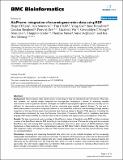| dc.contributor.author | Lam, Hugo YK | |
| dc.contributor.author | Marenco, Luis | |
| dc.contributor.author | Kinoshita, June | |
| dc.contributor.author | Shepherd, Gordon | |
| dc.contributor.author | Miller, Perry | |
| dc.contributor.author | Wu, Elizabeth | |
| dc.contributor.author | Wong, Gwendolyn T | |
| dc.contributor.author | Liu, Nian | |
| dc.contributor.author | Crasto, Chiquito | |
| dc.contributor.author | Morse, Thomas | |
| dc.contributor.author | Stephens, Susie | |
| dc.contributor.author | Cheung, Kei-Hoi | |
| dc.contributor.author | Clark, Timothy William | |
| dc.contributor.author | Gao, Yong | |
| dc.date.accessioned | 2011-04-28T07:08:43Z | |
| dc.date.issued | 2007 | |
| dc.identifier.citation | Lam, Hugo Y. K., Luis Marenco, Tim Clark, Yong Gao, June Kinoshita, Gordon Shepherd, Perry Miller, et al. 2007. AlzPharm: integration of neurodegeneration data using RDF. BMC Bioinformatics 8(Suppl 3): S4. | en_US |
| dc.identifier.issn | 1471-2105 | en_US |
| dc.identifier.uri | http://nrs.harvard.edu/urn-3:HUL.InstRepos:4878947 | |
| dc.description.abstract | Background: Neuroscientists often need to access a wide range of data sets distributed over the Internet. These data sets, however, are typically neither integrated nor interoperable, resulting in a barrier to answering complex neuroscience research questions. Domain ontologies can enable the querying heterogeneous data sets, but they are not sufficient for neuroscience since the data of interest commonly span multiple research domains. To this end, e-Neuroscience seeks to provide an integrated platform for neuroscientists to discover new knowledge through seamless integration of the very diverse types of neuroscience data. Here we present a Semantic Web approach to building this e-Neuroscience framework by using the Resource Description Framework (RDF) and its vocabulary description language, RDF Schema (RDFS), as a standard data model to facilitate both representation and integration of the data. Results: We have constructed a pilot ontology for BrainPharm (a subset of SenseLab) using RDFS and then converted a subset of the BrainPharm data into RDF according to the ontological structure. We have also integrated the converted BrainPharm data with existing RDF hypothesis and publication data from a pilot version of SWAN (Semantic Web Applications in Neuromedicine). Our implementation uses the RDF Data Model in Oracle Database 10g release 2 for data integration, query, and inference, while our Web interface allows users to query the data and retrieve the results in a convenient fashion. Conclusion: Accessing and integrating biomedical data which cuts across multiple disciplines will be increasingly indispensable and beneficial to neuroscience researchers. The Semantic Web approach we undertook has demonstrated a promising way to semantically integrate data sets created independently. It also shows how advanced queries and inferences can be performed over the integrated data, which are hard to achieve using traditional data integration approaches. Our pilot results suggest that our Semantic Web approach is suitable for realizing e-Neuroscience and generic enough to be applied in other biomedical fields. | en_US |
| dc.language.iso | en_US | en_US |
| dc.publisher | BioMed Central | en_US |
| dc.relation.isversionof | doi:10.1186/1471-2105-8-S3-S4 | en_US |
| dc.relation.hasversion | http://www.ncbi.nlm.nih.gov/pmc/articles/PMC1892101/pdf/ | en_US |
| dash.license | LAA | |
| dc.title | AlzPharm: integration of neurodegeneration data using RDF | en_US |
| dc.type | Journal Article | en_US |
| dc.description.version | Version of Record | en_US |
| dc.relation.journal | BMC Bioinformatics | en_US |
| dash.depositing.author | Clark, Timothy William | |
| dc.date.available | 2011-04-28T07:08:43Z | |
| dash.affiliation.other | HMS^Neurology-Massachusetts General Hospital | en_US |
| dc.identifier.doi | 10.1186/1471-2105-8-S3-S4 | * |
| dash.authorsordered | false | |
| dash.contributor.affiliated | Gao, Yong | |
| dash.contributor.affiliated | Clark, Tim | |


